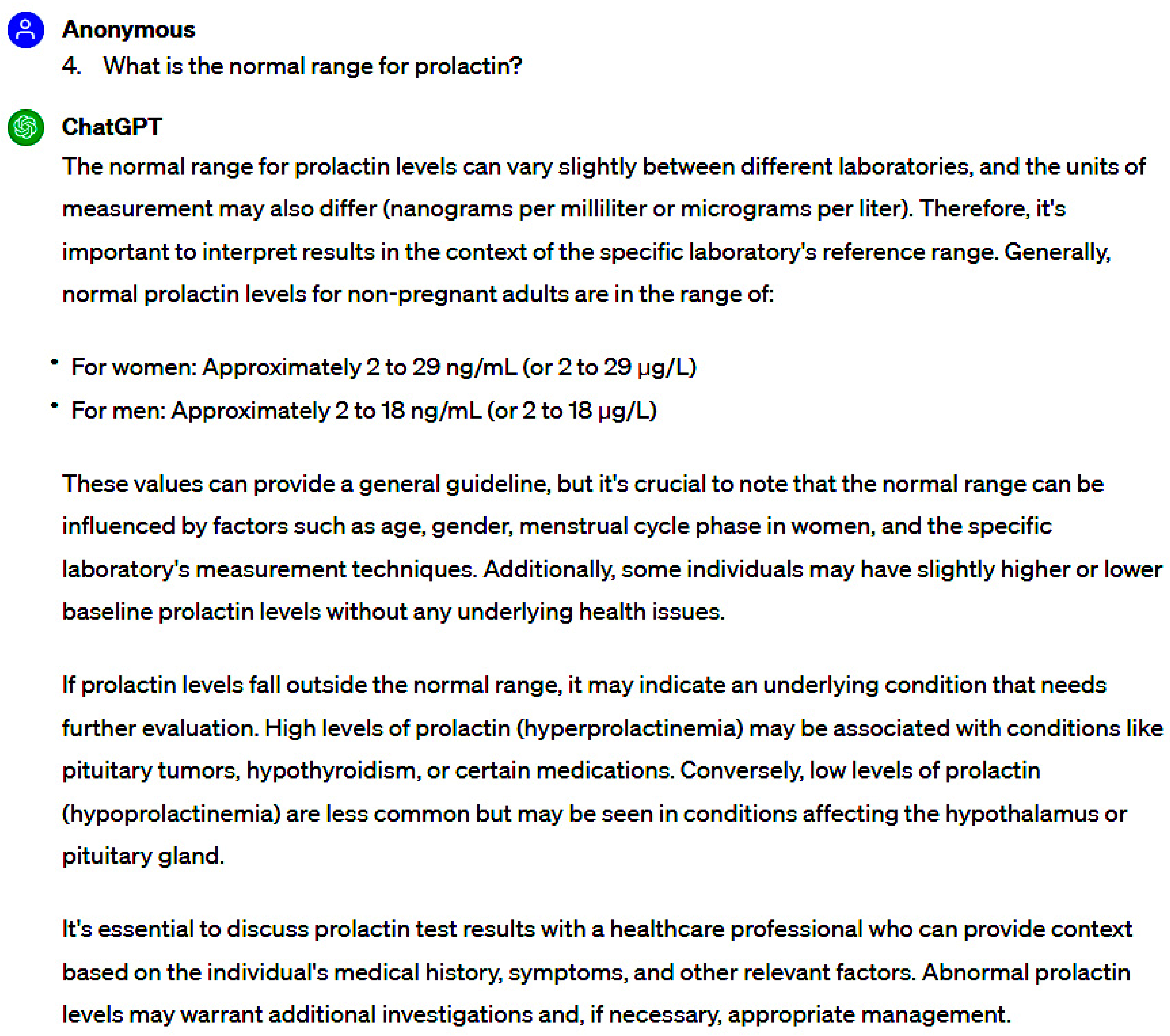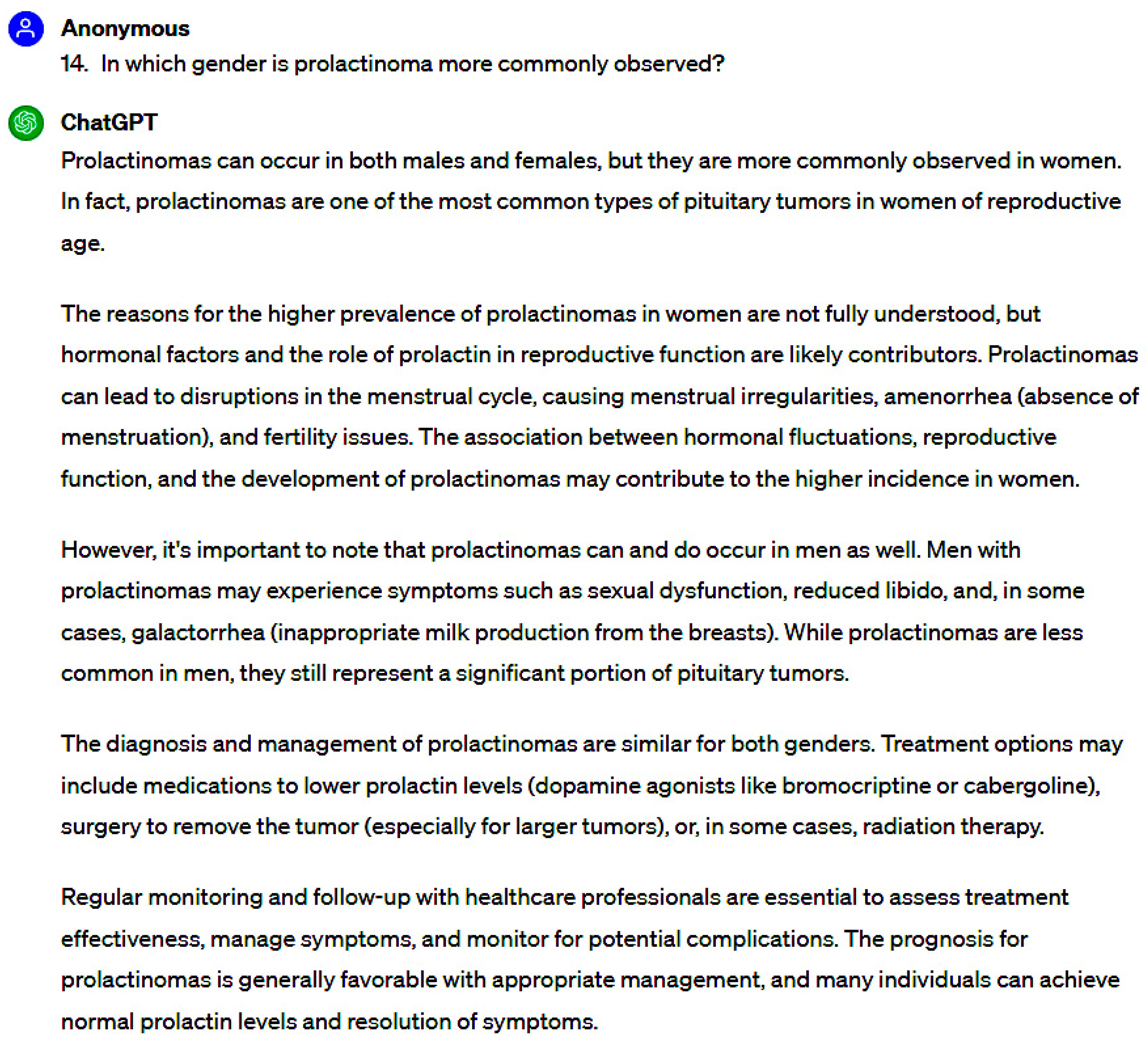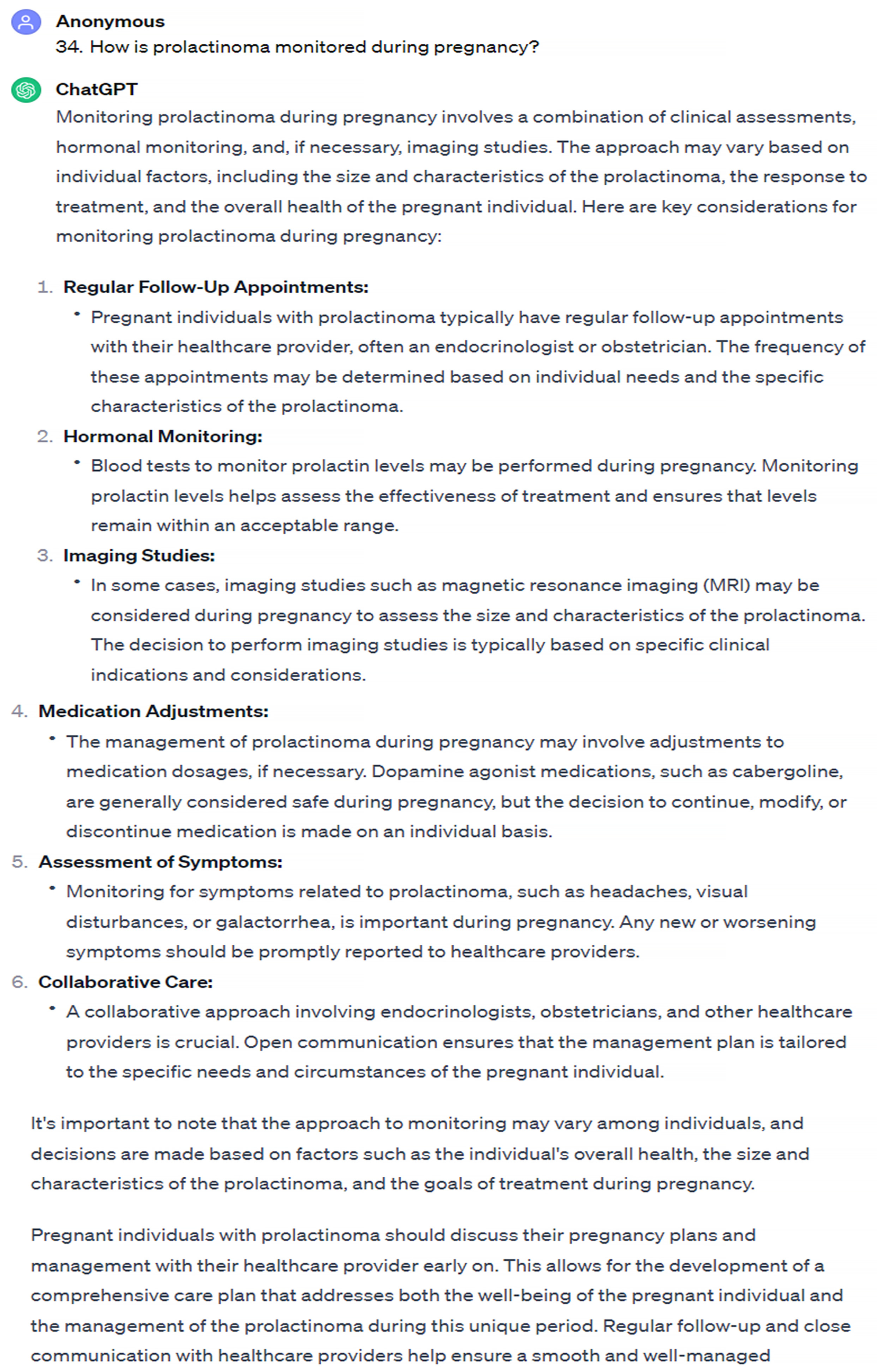The Role of Artificial Intelligence in Endocrine Management: Assessing ChatGPT’s Responses to Prolactinoma Queries
Abstract
1. Introduction
2. Materials and Methods
Statistical Analyses
3. Results
4. Discussion
5. Conclusions
Author Contributions
Funding
Institutional Review Board Statement
Data Availability Statement
Conflicts of Interest
References
- Vilar, L.; Vilar, C.F.; Lyra, R.; da Freitas, M.C. Pitfalls in the Diagnostic Evaluation of Hyperprolactinemia. Neuroendocrinology 2019, 109, 7–19. [Google Scholar] [CrossRef]
- Auriemma, R.S.; Pirchio, R.; Pivonello, C.; Garifalos, F.; Colao, A.; Pivonello, R. Approach to the Patient with Prolactinoma. J. Clin. Endocrinol. Metab. 2023, 108, 2400–2423. [Google Scholar] [CrossRef]
- Riedl, D.; Schüßler, G. The Influence of Doctor-Patient Communication on Health Outcomes: A Systematic Review. Z. Psychosom. Med. Psychother. 2017, 63, 131–150. [Google Scholar] [CrossRef] [PubMed]
- Ramezani, M.; Takian, A.; Bakhtiari, A.; Rabiee, H.R.; Ghazanfari, S.; Mostafavi, H. The Application of Artificial Intelligence in Health Policy: A Scoping Review. BMC Health Serv. Res. 2023, 23, 1416. [Google Scholar] [CrossRef] [PubMed]
- Dave, T.; Athaluri, S.A.; Singh, S. ChatGPT in Medicine: An Overview of Its Applications, Advantages, Limitations, Future Prospects, and Ethical Considerations. Front. Artif. Intell. 2023, 6, 1169595. [Google Scholar] [CrossRef] [PubMed]
- Khodve, G.B.; Banerjee, S. Artificial Intelligence in Efficient Diabetes Care. Curr. Diabetes Rev. 2023, 19, e050922208561. [Google Scholar] [CrossRef] [PubMed]
- Mese, I.; Taslicay, C.A.; Sivrioglu, A.K. Improving radiology workflow using ChatGPT and artificial intelligence. Clin. Imaging 2023, 103, 109993. [Google Scholar] [CrossRef]
- Ruksakulpiwat, S.; Kumar, A.; Ajibade, A. Using ChatGPT in Medical Research: Current Status and Future Directions. J. Multidiscip. Healthc. 2023, 16, 1513–1520. [Google Scholar] [CrossRef] [PubMed]
- Abbasgholizadeh Rahimi, S.; Légaré, F.; Sharma, G.; Archambault, P.; Zomahoun, H.T.V.; Chandavong, S.; Rheault, N.; Wong, T.; Langlois, L.; Couturier, Y.; et al. Application of Artificial Intelligence in Community-Based Primary Health Care: Systematic Scoping Review and Critical Appraisal. J. Med. Internet Res. 2021, 23, e29839. [Google Scholar] [CrossRef] [PubMed]
- Mohammad, B.; Supti, T.; Alzubaidi, M.; Shah, H.; Alam, T.; Shah, Z.; Househ, M. The Pros and Cons of Using ChatGPT in Medical Education: A Scoping Review. Stud. Health Technol. Inform. 2023, 305, 644–647. [Google Scholar] [CrossRef]
- Mondal, H.; Dash, I.; Mondal, S.; Behera, J.K. ChatGPT in Answering Queries Related to Lifestyle-Related Diseases and Disorders. Cureus 2023, 15, e48296. [Google Scholar] [CrossRef]
- Yeo, Y.H.; Samaan, J.S.; Ng, W.H.; Ting, P.-S.; Trivedi, H.; Vipani, A.; Ayoub, W.; Yang, J.D.; Liran, O.; Spiegel, B.; et al. Assessing the Performance of ChatGPT in Answering Questions Regarding Cirrhosis and Hepatocellular Carcinoma. Clin. Mol. Hepatol. 2023, 29, 721–732. [Google Scholar] [CrossRef] [PubMed]
- Rahsepar, A.A.; Tavakoli, N.; Kim, G.H.J.; Hassani, C.; Abtin, F.; Bedayat, A. How AI Responds to Common Lung Cancer Questions: ChatGPT versus Google Bard. Radiology 2023, 307, e230922. [Google Scholar] [CrossRef] [PubMed]
- Melmed, S.; Casanueva, F.F.; Hoffman, A.R.; Kleinberg, D.L.; Montori, V.M.; Schlechte, J.A.; Wass, J.A.H. Diagnosis and Treatment of Hyperprolactinemia: An Endocrine Society Clinical Practice Guideline. J. Clin. Endocrinol. Metab. 2011, 96, 273–288. [Google Scholar] [CrossRef] [PubMed]
- Casanueva, F.F.; Molitch, M.E.; Schlechte, J.A.; Abs, R.; Bonert, V.; Bronstein, M.D.; Brue, T.; Cappabianca, P.; Colao, A.; Fahlbusch, R.; et al. Guidelines of the Pituitary Society for the Diagnosis and Management of Prolactinomas. Clin. Endocrinol. 2006, 65, 265–273. [Google Scholar] [CrossRef]
- Petersenn, S.; Fleseriu, M.; Casanueva, F.F.; Giustina, A.; Biermasz, N.; Biller, B.M.K.; Bronstein, M.; Chanson, P.; Fukuoka, H.; Gadelha, M.; et al. Diagnosis and Management of Prolactin-Secreting Pituitary Adenomas: A Pituitary Society International Consensus Statement. Nat. Rev. Endocrinol. 2023, 19, 722–740. [Google Scholar] [CrossRef]
- Sierra, M.; Cianelli, R. Health Literacy in Relation to Health Outcomes: A Concept Analysis. Nurs. Sci. Q. 2019, 32, 299–305. [Google Scholar] [CrossRef]
- Kim, M.T.; Kim, K.B.; Ko, J.; Murry, N.; Xie, B.; Radhakrishnan, K.; Han, H.-R. Health Literacy and Outcomes of a Community-Based Self-Help Intervention: A Case of Korean Americans with Type 2 Diabetes. Nurs. Res. 2020, 69, 210–218. [Google Scholar] [CrossRef]
- Kim, K.; Shin, S.; Kim, S.; Lee, E. The Relation Between eHealth Literacy and Health-Related Behaviors: Systematic Review and Meta-Analysis. J. Med. Internet Res. 2023, 25, e40778. [Google Scholar] [CrossRef]
- Goodman, R.S.; Patrinely, J.R.; Stone, C.A.; Zimmerman, E.; Donald, R.R.; Chang, S.S.; Berkowitz, S.T.; Finn, A.P.; Jahangir, E.; Scoville, E.A.; et al. Accuracy and Reliability of Chatbot Responses to Physician Questions. JAMA Netw. Open 2023, 6, e2336483. [Google Scholar] [CrossRef]
- Ali, R.; Tang, O.Y.; Connolly, I.D.; Fridley, J.S.; Shin, J.H.; Zadnik Sullivan, P.L.; Cielo, D.; Oyelese, A.A.; Doberstein, C.E.; Telfeian, A.E.; et al. Performance of ChatGPT, GPT-4, and Google Bard on a Neurosurgery Oral Boards Preparation Question Bank. Neurosurgery 2023, 93, 1090–1098. [Google Scholar] [CrossRef] [PubMed]
- Samaan, J.S.; Yeo, Y.H.; Rajeev, N.; Hawley, L.; Abel, S.; Ng, W.H.; Srinivasan, N.; Park, J.; Burch, M.; Watson, R.; et al. Assessing the Accuracy of Responses by the Language Model ChatGPT to Questions Regarding Bariatric Surgery. Obes. Surg. 2023, 33, 1790–1796. [Google Scholar] [CrossRef] [PubMed]
- Takagi, S.; Watari, T.; Erabi, A.; Sakaguchi, K. Performance of GPT-3.5 and GPT-4 on the Japanese Medical Licensing Examination: Comparison Study. JMIR Med. Educ. 2023, 9, e48002. [Google Scholar] [CrossRef] [PubMed]




| Questions | Accuracy Score b | Adequacy Score c |
|---|---|---|
| What is prolactin? | 6 | 5 |
| What is the physiological role of prolactin in the body? | 6 | 5 |
| How is prolactin measured? | 6 | 3 |
| What is the normal range for prolactin? | 6 | 5 |
| What precautions should be taken before blood sampling for prolactin measurement? | 5.5 | 4 |
| What factors contribute to elevated levels of prolactin? | 6 | 5 |
| Which medications can increase prolactin levels? | 6 | 5 |
| What are the symptoms of hyperprolactinemia? | 6 | 4.5 |
| What is macroprolactinemia? | 6 | 4 |
| What is prolactinoma? | 6 | 5 |
| What are the symptoms of prolactinoma? | 6 | 4 |
| How is the diagnosis of prolactinoma established? | 5.5 | 3 |
| In which gender is prolactinoma more commonly observed? | 6 | 5 |
| How can it be determined whether the elevated prolactin is due to a pituitary adenoma? | 6 | 4 |
| What is macroprolactinoma? | 6 | 5 |
| What is the treatment for prolactinoma? | 6 | 5 |
| Should every patient be treated, or is it possible to opt for a conservative approach with regular monitoring without intervention? | 5 | 4.5 |
| How is cabergoline used in the treatment of prolactinoma? | 6 | 5 |
| What are the side effects of cabergoline? | 6 | 3 |
| How is bromocriptine used in the treatment of prolactinoma? | 5.5 | 4 |
| What are the side effects of bromocriptine? | 5 | 3 |
| In what situations is surgery required for prolactinoma? | 6 | 5 |
| Is radiotherapy administered in the treatment of prolactinoma? | 6 | 5 |
| What should be the target prolactin level with treatment? | 5 | 4.5 |
| How long should medication be administered in the treatment of prolactinoma? | 6 | 3 |
| Do symptoms completely resolve after treatment? | 5.5 | 3 |
| Can prolactinoma shrink with medical treatment? | 6 | 5 |
| Is it possible to achieve complete recovery from prolactinoma after treatment? | 6 | 4 |
| How often should a patient diagnosed with prolactinoma consult a doctor? | 5 | 2 |
| How often should an MRI be performed in prolactinoma cases? | 5 | 2.5 |
| Can there be a recurrence after discontinuing medication for prolactinoma? | 5.5 | 3.5 |
| Can patients with prolactinoma conceive? | 5 | 3 |
| How is prolactinoma monitored during pregnancy? | 2 | 3 |
| How is prolactinoma treated during pregnancy? | 2 | 3 |
| In a pregnant patient with prolactinoma, when should medical treatment be discontinued? | 5 | 3.5 |
| Can women with prolactinoma use medication after childbirth? | 5 | 3.5 |
| Is breastfeeding allowed for a patient with prolactinoma after childbirth? | 5 | 4 |
| Should postmenopausal prolactinoma be treated? | 5.5 | 4 |
| What are the complications of elevated prolactin levels? | 6 | 4.5 |
| Which other hormones are affected by hyperprolactinemia? | 5.5 | 5 |
| What ocular manifestations are associated with prolactinoma? | 6 | 5 |
| Does prolactinoma cause headaches? | 6 | 5 |
| Does elevated prolactin affect sexual function in men? | 6 | 5 |
| Does hyperprolactinemia cause menstrual irregularities? | 6 | 5 |
| Is it possible to conceive while having elevated prolactin levels? | 6 | 5 |
| General Information | Diagnostic Process | Treatment Process | Follow-Up | Pregnancy Period | Total | p Value | |
|---|---|---|---|---|---|---|---|
| Rater 1 | |||||||
| Median (IQR) | 6.0 (6.0–6.0) | 6.0 (6.0–6.0) | 6.0 (5.5–6.0) | 6.0 (5.0–6.0) | 5.0 (2.5–5.7) | 6.0 (5.8–6.0) | 0.001 |
| Mean (SD) | 6.0 (0.0) | 6.0 (0.0) | 5.8 (0.4) | 5.7 (0.5) | 4.4 (1.6) | 5.6 (0.9) | |
| Rater 2 | |||||||
| Median (IQR) | 6.0 (6.0–6.0) | 6.0 (6.0–6.0) | 6.0 (5.0–6.0) | 5.0 (5.0–6.0) | 5.0 (2.5–5.7) | 6.0 (5.0–6.0) | 0.015 |
| Mean (SD) | 5.8 (0.3) | 5.8 (0.4) | 5.5 (0.5) | 5.4 (0.5) | 4.4 (1.6) | 5.5 (0.9) | |
| Average Score | |||||||
| Median (IQR) | 6.0 (6.0–6.0) | 6.0 (6.0–6.0) | 6.0 (5.2–6.0) | 5.5 (5.0–6.0) | 5.0 (2.5–5.7) | 6.0 (5.4–6.0) | 0.005 |
| Mean (SD) | 5.9 (0.2) | 5.9 (0.2) | 5.7 (0.4) | 5.5 (0.5) | 4.4 (1.6) | 5.5 (0.9) | |
| General İnformation | Diagnostic Process | Treatment Process | Follow-Up | Pregnancy Period | Total | p Value | |
|---|---|---|---|---|---|---|---|
| Rater 1 | |||||||
| Median (IQR) | 5.0 (4.5–5.0) | 5.0 (4.0–5.0) | 5.0 (3.5–5.0) | 4.0 (3.0–4.5) | 3.0 (3.0–4.8) | 5.0 (3.0–5.0) | 0.018 |
| Mean (SD) | 4.8 (0.4) | 4.6 (0.8) | 4.4 (0.9) | 3.6 (1.0) | 3.6 (0.9) | 4.3 (0.9) | |
| Rater2 | |||||||
| Median (IQR) | 5.0 (4.0–5.0) | 5.0 (4.0–5.0) | 4.0 (3.5–5.0) | 3.0 (2.5–4.5) | 4.0 (3.0–4.8) | 4.0 (3.0–5.0) | 0.059 |
| Mean (SD) | 4.7 (0.5) | 4.4 (0.8) | 4.2 (0.8) | 3.0 (1.1) | 3.9 (0.8) | 4.1 (0.9) | |
| Average Score | |||||||
| Median (IQR) | 5.0 (4.2–5.0) | 5.0 (4.0–5.0) | 4.5 (3.5–5.0) | 3.5 (2.7–4.5) | 3.5 (3.0–4.8) | 4.5 (3.5–5.0) | 0.023 |
| Mean (SD) | 4.9 (1.1) | 4.5 (0.8) | 4.3 (0.8) | 3.5 (1.1) | 3.8 (0.8) | 4.2 (0.9) | |
Disclaimer/Publisher’s Note: The statements, opinions and data contained in all publications are solely those of the individual author(s) and contributor(s) and not of MDPI and/or the editor(s). MDPI and/or the editor(s) disclaim responsibility for any injury to people or property resulting from any ideas, methods, instructions or products referred to in the content. |
© 2024 by the authors. Licensee MDPI, Basel, Switzerland. This article is an open access article distributed under the terms and conditions of the Creative Commons Attribution (CC BY) license (https://creativecommons.org/licenses/by/4.0/).
Share and Cite
Şenoymak, M.C.; Erbatur, N.H.; Şenoymak, İ.; Fırat, S.N. The Role of Artificial Intelligence in Endocrine Management: Assessing ChatGPT’s Responses to Prolactinoma Queries. J. Pers. Med. 2024, 14, 330. https://doi.org/10.3390/jpm14040330
Şenoymak MC, Erbatur NH, Şenoymak İ, Fırat SN. The Role of Artificial Intelligence in Endocrine Management: Assessing ChatGPT’s Responses to Prolactinoma Queries. Journal of Personalized Medicine. 2024; 14(4):330. https://doi.org/10.3390/jpm14040330
Chicago/Turabian StyleŞenoymak, Mustafa Can, Nuriye Hale Erbatur, İrem Şenoymak, and Sevde Nur Fırat. 2024. "The Role of Artificial Intelligence in Endocrine Management: Assessing ChatGPT’s Responses to Prolactinoma Queries" Journal of Personalized Medicine 14, no. 4: 330. https://doi.org/10.3390/jpm14040330
APA StyleŞenoymak, M. C., Erbatur, N. H., Şenoymak, İ., & Fırat, S. N. (2024). The Role of Artificial Intelligence in Endocrine Management: Assessing ChatGPT’s Responses to Prolactinoma Queries. Journal of Personalized Medicine, 14(4), 330. https://doi.org/10.3390/jpm14040330





